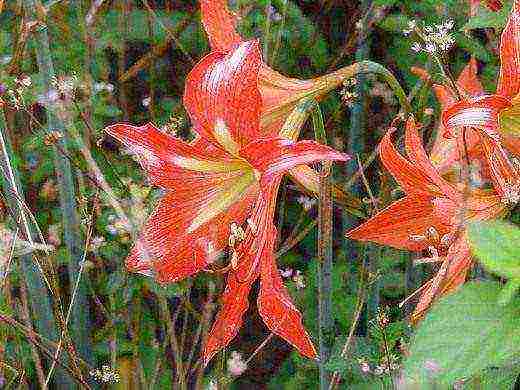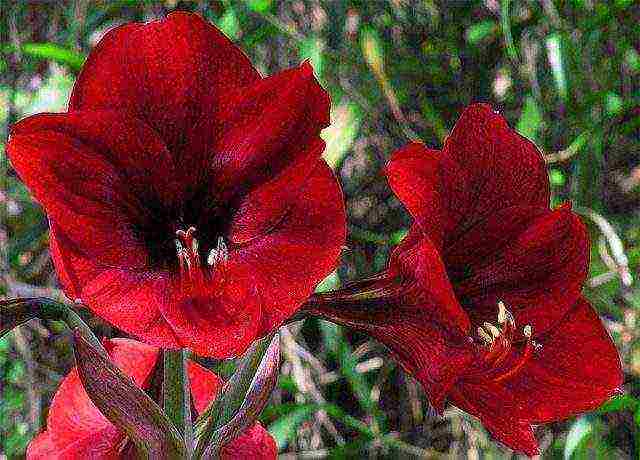Content
- 1 Description of hippeastrum
- 2 Optimal conditions for growing a flower
- 3 Planting and transplanting
- 4 Basic rules for caring for hippeastrum
- 5 Diseases and pests of the hippeastrum
- 6 Reproduction
- 7 Gardeners reviews
- 8 Hippeastrum: plant features
- 9 How and when to transplant hippeastrum?
- 10 Lighting for growing hippeastrum
- 11 Air temperature and features of watering when growing hippeastrum
- 12 Top dressing of hippeastrum
- 13 General information about Hippeastrum
- 14 Home phytodesign in the highest class
- 15 Hippeastrum home care
- 16 We alternate flowering with rest
- 17 Watering and feeding
- 18 Transfer
- 19 Which breeding method should you choose?
- 20 Growing problems: how to fix them?
Blooming hippeastrum fascinates with its beauty. Only once a year, he pleases us with huge flowers-stars. And what is the disappointment when the long-awaited flower does not appear, or the plant begins to wilt altogether. To avoid such troubles and be able to enjoy the contemplation of this wonderful flower, you need to know some secrets of care and adhere to them. A grateful plant will surely delight the eye with generous flowering.
Description of hippeastrum
Appearance
Hippeastrum (Latin Hippeastrum) is a perennial bulbous plant. Leaves are linear, shiny leaves, 50–70 cm long, 4–5 cm wide, have shallow grooves on the surface. The leaves are arranged in two rows. During the flowering period, the plant produces a powerful, high (up to 60–80 cm) peduncle.
The name of the flower is translated from ancient Greek as "star rider".
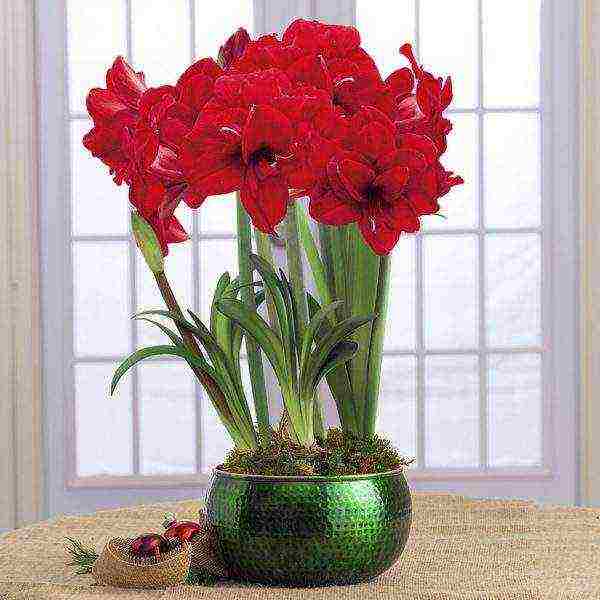
Hippeastrum during flowering - a subject of pride and admiration
The flowers are funnel-shaped. Their color range is quite wide: reds, whites, oranges, pinks, purples, sometimes yellow or greenish shades. The main tone can be complemented by strokes or specks.
The flowers are large - up to 20 cm in diameter, collected in an umbrella inflorescence. Hippeastrum has a very faint odor. Some species don't smell at all. This is a great benefit for people prone to allergic reactions.
Flowering hippeastrum - video
Natural habitat and home maintenance
The homeland of the hippeastrum is the American tropics and subtropics, in particular the Amazon basin.It was introduced to Europe in the 16th century and quickly gained admirers all over the world. In 1799, Johnson's first hybrid hippeastrum was introduced. Today these flowers are widely used as a houseplant and are also grown for cutting. Hippeastrum is not very difficult to care for. Even novice growers can easily cope with this task.
Variety of varieties of hippeastrum
This plant belongs to the Amaryllis family and has about 90 species and more than 2 thousand varieties.
In indoor floriculture, hippeastrum hybrida is most often cultivated. The classification of varietal hippeastrum is based on two characteristics: the size and shape of the flower. Depending on this, plants are conventionally divided into 9 groups, which are indicated in the table.
The most popular groups and varieties of hippeastrum - table
Magnificent hippeastrum in the photo
Similarities and differences with amaryllis
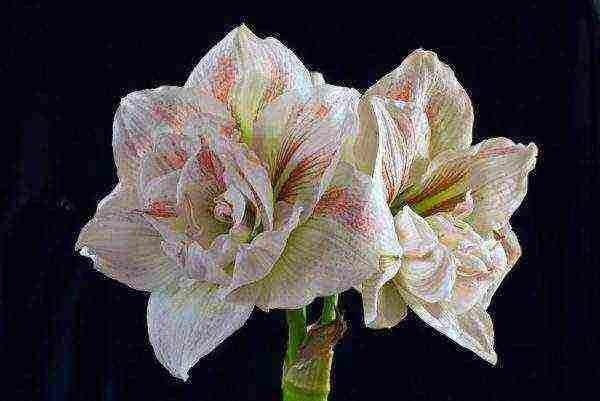
Amaryllis is often referred to as hippeastrum varieties, but this is mistaken
Hippeastrum is often confused with amaryllis or the names of these flowers are considered synonymous. Even on sale hippeastrum can go under the name "amaryllis" or vice versa. They are indeed relatives belonging to the same botanical family - amaryllidaceae, but representing different genera.
Outwardly, these plants are very similar and require almost the same care. Biologically, they are arranged in different ways. The main differences are presented in the table.
Biological differences between hippeastrum and amaryllis - table
Optimal conditions for growing a flower
The practice of cultivating this plant shows that the beauty of the hippeastrum depends on the optimal parameters of temperature, humidity and illumination. Intense bloom provides a full dormant period in a dark, dry and cool place for at least 8-10 weeks. "Tired" hippeastrum most often gives small flowers on a short peduncle or does not bloom at all.
At the moment the bulb wakes up, the conditions should be gradually (but not drastically) changed: transfer the plant to a warm, but not too brightly lit room and increase watering to moderate. Thus, the formation and development of peduncles is stimulated. In cold climates, this process is greatly slowed down.
If a plant hits bright light from the dark, in combination with excess moisture, it stimulates the rapid growth of the green mass, but noticeably inhibits the development of the peduncle.
In order for the hippeastrum to develop fully, it is necessary to observe the growing conditions given in the table.
Growing conditions for hippeastrum at different periods of development - table
Planting and transplanting
The planting time of the hippeastrum bulbs can be selected depending on the desired flowering period. This can be done regardless of the season. The plant will delight you with flowers about 5-9 weeks from the moment the shoots appear. Hippeastrum bulbs sold through the distribution network are ready to bloom. They have gone through a dormant period and do not need darkness.
Planting requires a deep (up to 15 cm) and narrow (no more than 5–6 cm larger than the bulb diameter) pot, preferably ceramic, always stable on a horizontal surface. A narrow pot is necessary to prevent excessive moisture and root rot. As an optimal substrate, you should use drainage, which fills the lower part of the pot, and a soil mixture consisting of equal parts of sand, turf, humus or peat.
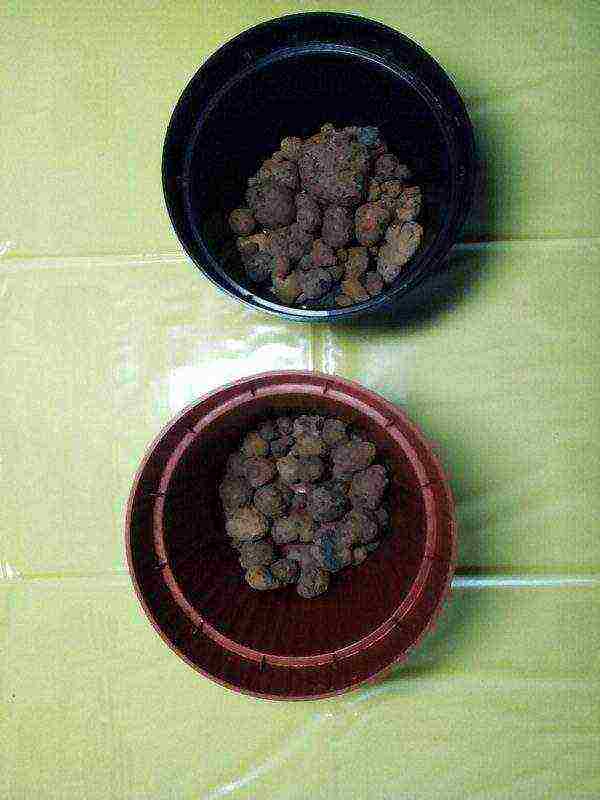
Drainage is a prerequisite for preventing excessive soil moisture and rotting of the bulb and roots
The bulb is planted in a slightly damp soil mixture, deepening it to a maximum of 2/3 of the height.
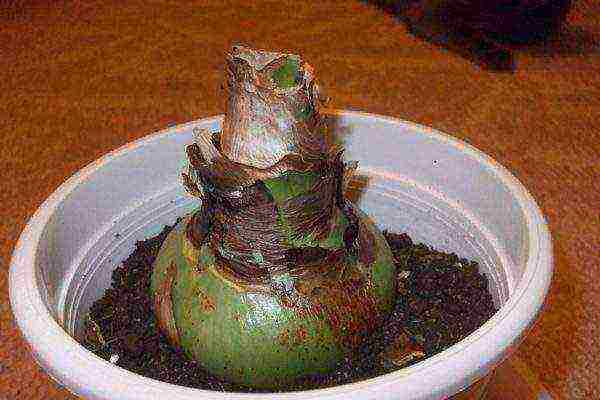
Narrow pot and shallow planting create optimal conditions for the hippeastrum
After planting, the plant only needs warmth. It is not necessary to water the hippeastrum before the sprouts appear.
If any damage is noticed on the bulb, it must first be healed. This procedure includes trimming rotten parts, keeping for 30 minutes in a fungicide solution (Fundazol, Maxima) or ordinary greenery and drying for a day.
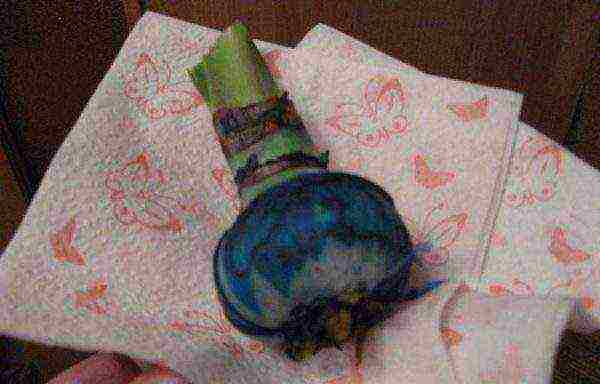
Processed hippeastrum bulb
It is necessary to plant such a bulb in the ground, where humus is replaced with a small amount of sphagnum (peat moss).
It is advisable to deepen the reanimated bulb into the soil no more than 1/4 of its height. With such a planting, it is easier to control its condition and, if necessary, carry out spraying. After the bulbs have recovered, the soil mixture can be easily refilled to the usual level.
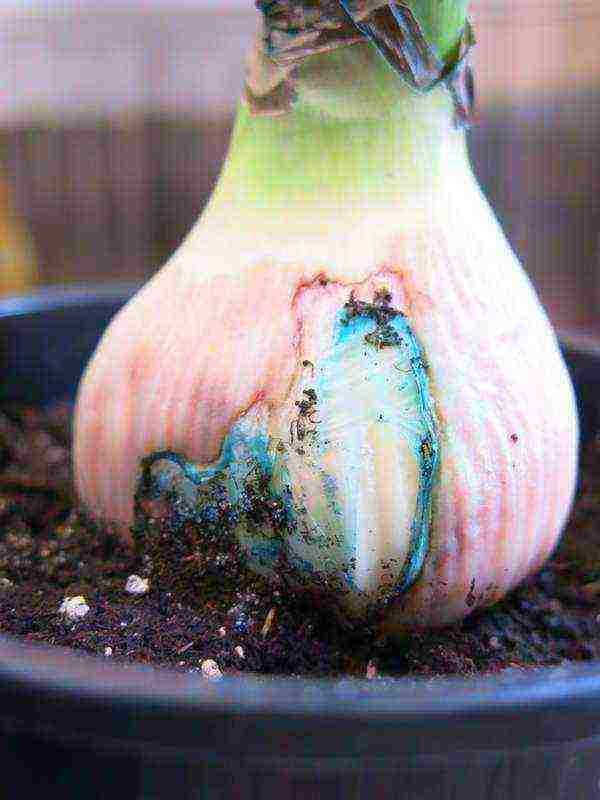
Surface planting of a damaged bulb
Having planted the plant in moistened soil, it is placed in a warm, slightly shaded place (you can cover it with an empty pot) and watering is excluded until the peduncle is distilled to a height of 10 cm.
The optimal frequency of hippeastrum transplant is once every 3-4 years. A favorable time is the eve of the dormant period or its end. It is advisable to use the transshipment method when transplanting - to move the plant along with the earthen clod. In this case, the root system is minimally damaged, which contributes to the rapid rooting of the bulb and its active development.
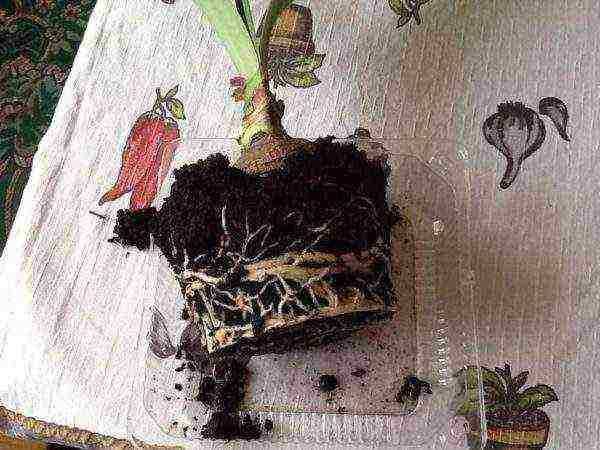
Transfer method - a method of transplanting with minimal damage to the root system
Basic rules for caring for hippeastrum
Watering and feeding
As discussed above, the intensity of watering the hippeastrum is directly related to its life cycle. However, it is important to provide the plant with not only the required amount of moisture, but also correctly deliver it to the root system.
For example, it is not recommended to pour water on the bulb - it can rot. Better to combine top watering with pan watering. Thus, moisture will be evenly distributed over the earthen coma, which will exclude root rot. The main rule of watering hippeastrum: it is better to underfill than overflow. You also need to regularly wipe the leaves from dust or wash them with warm water.
During the growth of the peduncle, when it reaches a height of 12-15 cm, it is useful to water the soil with a weak solution of potassium permanganate. After 5-6 days after that, you need to feed the plant with phosphorus fertilizer.
Top dressing of hippeastrum is carried out regularly, at the beginning of the growing season - once every two weeks with liquid nitrogen-phosphorus-potassium (7: 3: 6) fertilizer (for deciduous plants). After the appearance of leaves, to stimulate the active formation of buds, hippeastrum requires less nitrogen and much more potassium, so the ratio of mineral components changes to the proportions of 4: 6: 12 (for flowering plants). The frequency of feeding is maintained.
A month before the onset of the dormant period, the hippeastrum needs fertilizers with an insignificant part of nitrogen and phosphorus and a large amount of potassium (4: 4: 12).
Carefully read the method of applying fertilizers on the packaging and do not exceed the indicated concentration of minerals. Otherwise, the root system of the plant can be burned.
Timely balanced feeding contributes to high-quality flowering and deciduous growth. The base of the leaves forms the scales of the bulb and it grows in size. With insufficient nutrition or a complete lack of feeding, the bulb will use the nutrients accumulated from the leaves, but they are not enough to ensure flowering.
Some secrets of flowering
Sometimes hippeastrum disappoints flower growers by refusing to bloom. Why? There may be several reasons:
- Most often, the plant does not throw out a peduncle due to the depletion of the bulb. Hippeastrum requires a substantial amount of nutrients for flowering. Unsurprisingly, the potted soil is rapidly depleted. To avoid such problems, it is necessary to feed regularly and in sufficient quantities.
- A plant affected by pests (spider mites, worms or scabbards) tries to fight them and does not have the strength to bloom.
- Hippeastrum does not bloom even with rotting of the bulb, which occurs due to waterlogging of the soil.
To admire the blooming hippeastrum from year to year, one should not allow such situations. It is also useful to know some tricks of experienced florists to ensure 100% flowering of this plant:
- treating the bulb with hot (43–45 ºC) water for three hours before planting will cause the plant to bloom in three weeks;
- if you stop watering from August, move the plant to a dark, dry place and keep it there until the end of January, after which you resume watering, the flowers will delight you in 1.5 months;
- if you cut off all the leaves in July and do not water the hippeastrum for a month, and with the first watering introduce liquid complex fertilizing, the flowers will bloom in August or September.
In order to avoid scalding the roots, fertilizer should be applied only after preliminary moistening of the soil.
Immediately after flowering, it is necessary to cut off the wilted peduncle, continuing watering and feeding. And prepare the plant for good rest (dormant period). The next flowering directly depends on this.
Dormant period
The natural resting period of the hippeastrum lasts quite a long time: from September to January. If your plant grew outdoors in summer, by the beginning of autumn it must be brought into the house and gradually reduce watering until the leaves completely stop and dry out. You can trim the yellowed leaves yourself, from which the bulb has already taken nutrients.
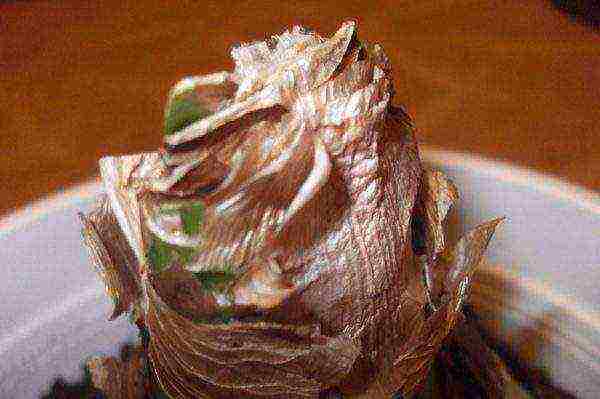
The quality of the next flowering depends on the dormant period.
After that, you should put (or put the pot with the plant on its side) in a dark and cool (5-12 ° C) room. Many growers keep them at a higher temperature - about 17-18 ° C. The soil should be slightly moistened once every 2-3 weeks to prevent drying out of the roots. It is not recommended to moisten and spray the onion.
The dormant period should last 1.5–3 months, depending on the planned time of the subsequent flowering of the plant. During this time, the hippeastrum does not "show signs of life." The development of leaves and peduncles occurs only inside the bulb.
After a period of rest, it is time for the hippeastrum to wake up. Leaves and peduncles appear on the surface of the bulb.
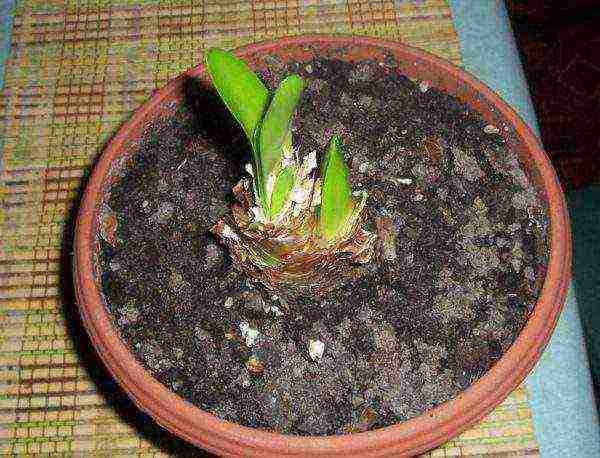
Simultaneous appearance of leaves and peduncle
Problems waking up after wintering
If the bulb does not wake up, you can, of course, be patient and wait for it to wake up on its own. But, as a rule, full-fledged flowering from the "belated" bulb will not work.
In this case, it is worth remembering in what state the plant “retired”. After all, the peduncle is laid in the bosom of every fourth leaf. If last year the green mass was not sufficiently grown, the bulb will be weakened.
And if there were less than four leaves, then in the new season the hippeastrum will probably refuse to bloom. Dry content can hardly be helped here. It is necessary to provide a very warm temperature, actively water and feed.
Care errors and their correction
It is not very difficult to care for hippeastrum, but it is imperative to follow the rules of watering, feeding and lighting at different periods of the plant's life cycle.
Common mistakes in caring for hippeastrum - table
Diseases and pests of the hippeastrum
Hippeastrum is not too susceptible to disease. It is most often affected by a red burn (red burn fungus or stagonosporosis), red rot and downy mildew. Some pests can also bother this plant: spider mites, scale insects, aphids, worms. You can determine what a plant is sick with by its appearance.
The main diseases and pests of the hippeastrum and how to deal with them - table
The most common diseases and pests of the hippeastrum in the photo
Reproduction
Hippeastrum reproduces in two ways: seed and vegetative.
Seed method
The seed method is rather complicated and time-consuming. Seeds are formed only 1.5–2 months after flowering. But they do not form on their own. It is necessary to artificially pollinate pistils and stamens. The grown ovary looks like a large tricuspid capsule.
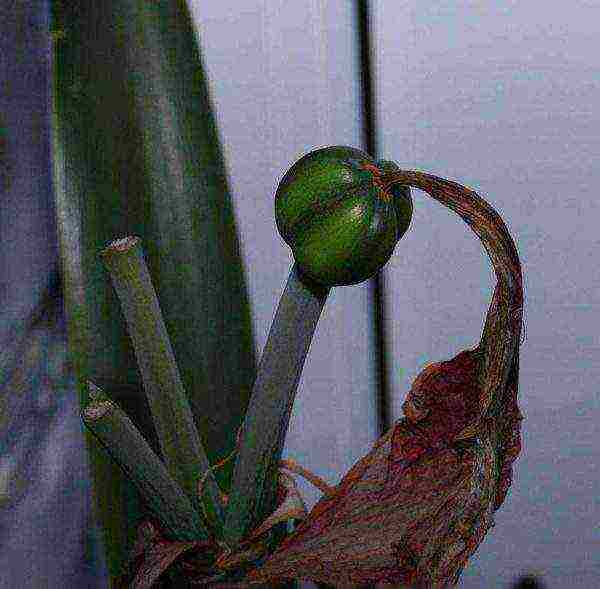
Ripening of hippeastrum seeds
Inside the capsule, there are rows of flattened seeds of an irregular rounded shape. They are characterized by a black color with a brown tint and the presence of thin black wings.
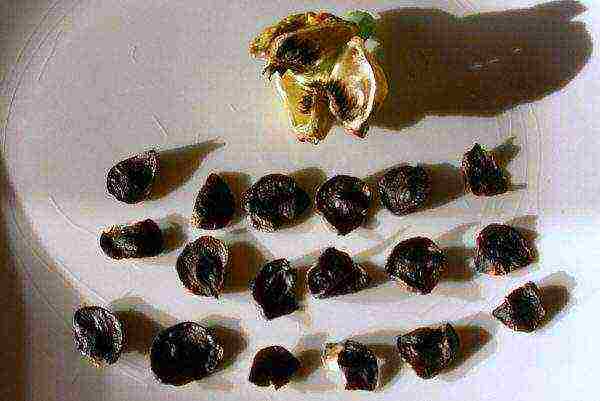
Seeds ready for sowing
In the spring, they are planted in sandy-leafy soil. It is important to take into account that freshly harvested seeds have one hundred percent germination. From dried seeds, as a rule, only 30% of the total germinate. Seedlings will delight you in 15–5 days.
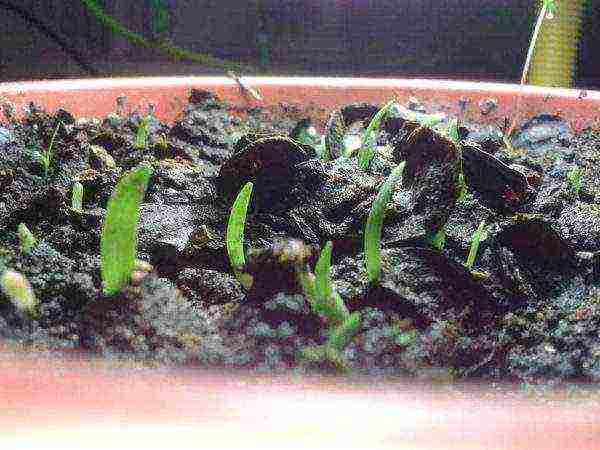
Sprouted hippeastrum seeds
When the leaves grow to 6–10 cm, they are transplanted into pots with a diameter of 6–7 cm. At this time, the bulb grows.
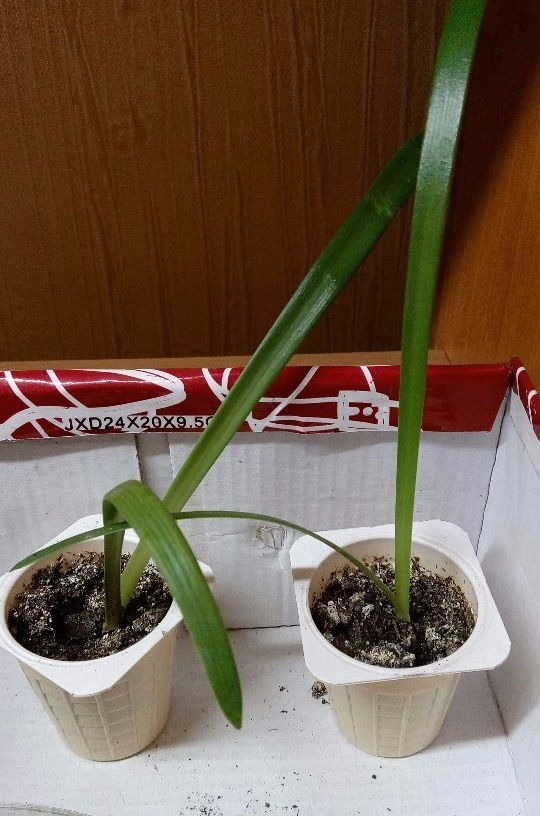
Grown seedlings of hippeastrum
The period until the first flowering of young plants of different varieties ranges from two to five years. This method is more acceptable to breeders. Most amateur flower growers consider it costly and ineffective. At the same time, there is no guarantee of the preservation of the maternal characteristics of the plant.
Vegetative method
It is much easier to propagate hippeastrum in a vegetative way. Several variants of it are practiced.
Propagation by daughter bulbs
This is a natural, and therefore the most optimal and simplest way. Bulbs of three years of age, with proper care, usually give 3 babies.
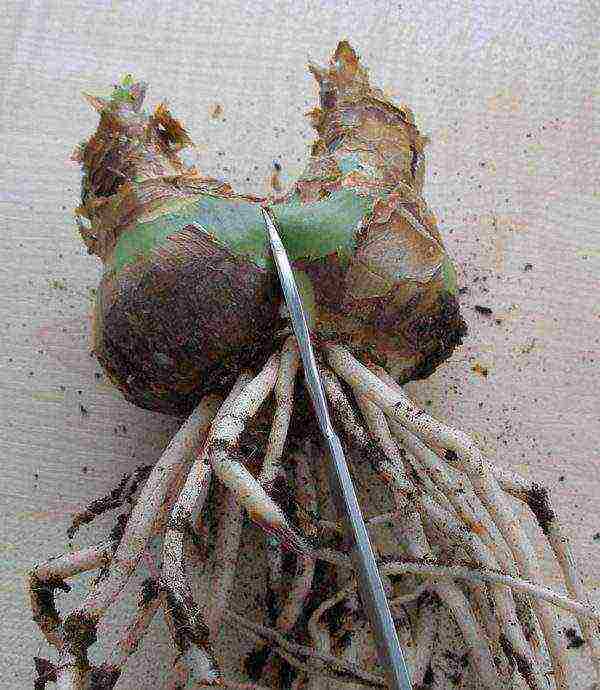
Separating the bulbs
They are separated with a sterile sharp instrument, treating the cuts with crushed coal. Planted in accordance with the rules for planting an adult bulb.
For two years, the newly planted plant is not deprived of its foliage and is not set to rest. The growth of the bulb and the formation of the peduncle in it depends on the intensity of the growth of the leaves. With good care, babies will throw out flower stalks in 2-3 years.
Dividing the bulb
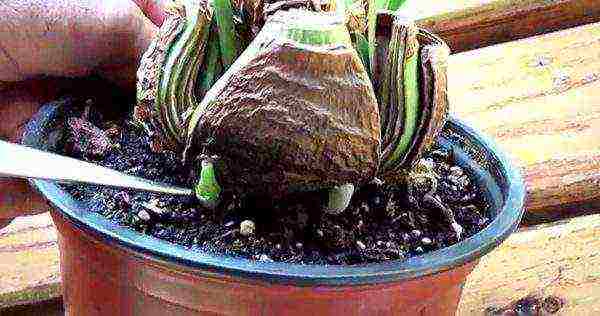
Split onion
The division is carried out during the maximum accumulation of nutrients in the bulb - in November.
Division process algorithm:
- Remove the top layer of the soil, leaving only the lower part of the bulb in the soil.
- Remove dry outer scales.
- Cut off the leaves along with the top of the bulb.
- Cut the onion into four equal parts to the surface of the soil.
- Insert knitting needles with a diameter of 5–6 cm into the incisions to prevent the parts of the bulb from closing.
- Adhere to all the rules of caring for an adult plant.
- With the appearance of leaves, feed and continue fertilizing according to the standard scheme.
- Divide the onion the following spring and place the parts in separate flowerpots.
You can divide the onion in another way: cut it, leaving a piece of the bottom and scales in each part. It is useful to sprinkle the sections with charcoal or activated carbon. Plant the resulting slices in a light peat mixture.
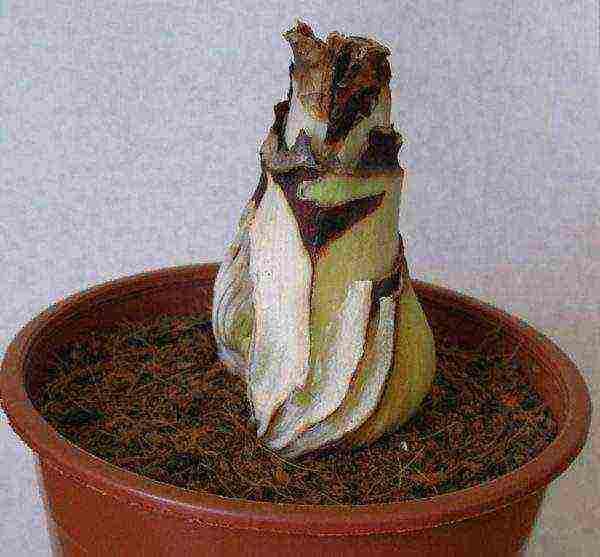
shallow planting in a light substrate
After 40-50 days, babies appear, which must be planted in pots in the spring.
Attention! When seating, one should not forget about the presence of toxic substances in the bulbs of the hippeastrum and adhere to safety rules.
Gardeners reviews
Pluses: easy to clean.
Disadvantages: This is my favorite flower, so there are no disadvantages at all.
I have two adult hippeastrum. Let's start with a dormant period. They have it under the kitchen sink, and I hardly water them. Just a little once a month. When the dormant period ends, I take out the flowers on the window and do not water until an arrow with a bud appears. Now you can water and gradually increase watering. If you start watering right away, without waiting for the arrow, then you risk not getting bloom. Strong foliage will just start to grow, and the bud will not appear.
They multiply by bulbs very slowly. Therefore, I came up with the idea to pollinate them artificially and get seeds for sowing.Pollinated during flowering, they both bloomed at the same time. I just took a cotton swab and transferred the pollen from one flower to the pistil of another. Usually, after flowering, the flower dries up and falls off. At the same time, a green box was formed, in which there were seeds. When the box dried up and began to crack, I collected the seeds and sowed them in the ground to a depth of 1 centimeter in the fall. The first shoots appeared at the end of winter. What a joy it was))) There are 34 of them in the flowerpot, they are preparing for transplantation. These babies will bloom in about 2.5-3 years. It's only a shame that the hippeastrum grown in this way does not preserve the specific features of the parent plant. That is, my mother plant is red, but these small hippeastrum will bloom with completely different flowers, which will differ in shade and shape. But this is even more interesting.
Kseny687654
Advantages: gorgeous flowering, unpretentiousness.
Disadvantages: blooms for only a few days.
I want to share with everyone a piece of my joy. I have two hippeastrum blossoms at once, it's right for my birthday! A wonderful gift! In general, hippeastrum are bulbous plants with juicy, long, green leaves, with huge flowers (there are up to 6 of them on one peduncle), each of the flowers is up to 25 cm in diameter! I have a little smaller, but nevertheless also large, especially on white. They bloom depending on the variety at different times. Flowers must have a dormant period for this. For example, mine have just faded, now they have released their leaves, they are in the process of growing. I water them (moderately), feed them, and they stand in the light. They will have a dormant period from October to February. By this time, their watering should be reduced. I put them in a dark place and gradually stop watering. Maximum once a month, and sometimes even less. The leaves that were on the flowers dry out and are easily removed. We take out the plant when the first leaves begin to hatch, put it on the windowsill and start watering. By the way, after flowering, we cut the peduncle so that its height is 15 cm, and then, when it dries, we separate it from the plant by hand. Propagated by bulbs and seeds. In the first case, flowering occurs in 3-4 years, and in the second - in 8 years. The plant is unpretentious and is not susceptible to almost any disease.
Lisichkina
Hippeastrum care is available even for very busy people. It requires a minimum of effort and provides maximum aesthetic pleasure. You will fall in love with this "star rider" at the first bloom. Grow and welcome spring with wonderful flowers in February!
By specialty - commodity expert of non-food products. I work as a teacher of commercial and commodity disciplines.
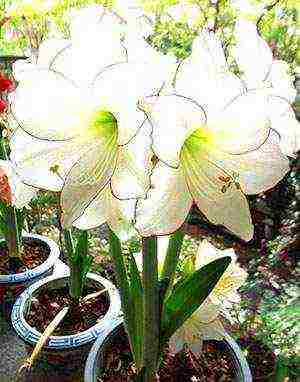 In the wild, hippeastrum are found in South America, with a number of species found in subtropical climates and tropics, while others prefer rocky slopes where conditions for growth are very harsh. The first bulbs came to Europe in the second half of the 16th century, and the flowering of the hippeastrum made a huge impression in the countries of the Old World, where the fashion for bulb crops was gaining strength.
In the wild, hippeastrum are found in South America, with a number of species found in subtropical climates and tropics, while others prefer rocky slopes where conditions for growth are very harsh. The first bulbs came to Europe in the second half of the 16th century, and the flowering of the hippeastrum made a huge impression in the countries of the Old World, where the fashion for bulb crops was gaining strength.
Gradually the plant was studied, the Europeans learned how to grow hippeastrum and how to care for the flower. Within a hundred years, the first hybrid plants were bred. And if in nature there are several dozen species of these bulbous plants, then the number of varieties already exceeds two thousand. Today, any florist who has ever seen the spectacular flowering of hippeastrum will certainly not leave the thought of decorating his own windowsill with a luxurious plant.
Hippeastrum: plant features
Depending on the type and age, the hippeastrum bulb has a diameter of 5 to 10 cm and consists of a short section of the stem and surrounding closed scales.
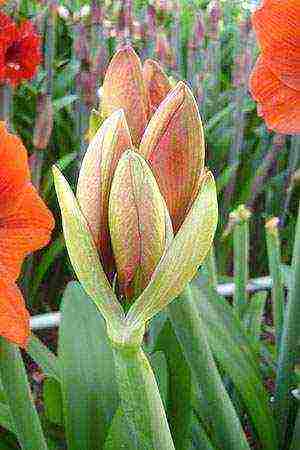 In the sinus of every fourth scale, rudiments are formed:
In the sinus of every fourth scale, rudiments are formed:
- peduncle, as it grows, reaching a height of 40–80 cm;
- future large, collected in inflorescences of 2-6 pieces of flowers.
The leaves of the hippeastrum are located opposite each other, in width, depending on the variety, do not exceed 4–5 cm, and reach 50–70 cm in length. A flower grower who is going to start growing hippeastrum should know that the year of this plant is divided into three distinct period:
- flowering;
- vegetation;
- rest.
When the long-awaited time of flowering comes, red, white pink, striped and spotted flowers sitting on the petioles open on the tops of the hollow peduncles.
Large bulbs can form two or three peduncles, but specimens with less than four leaves or not reaching a diameter of 6-7 cm this season are unlikely to please with flowering.
 Leaves appear one at a time approximately once a month, when, after flowering, the plant retires for 2 to 3 months, there are no external signs of bulb development, but it is actively accumulating strength. Arrows with bright colors appear once a year, but with proper care, as in the photo, hippeastrum at home twice pleases with flowering. The timing and duration of this period depends on the selected variety, the characteristics of care, in particular, on the temperature in the room. On average, flowering lasts about three weeks.
Leaves appear one at a time approximately once a month, when, after flowering, the plant retires for 2 to 3 months, there are no external signs of bulb development, but it is actively accumulating strength. Arrows with bright colors appear once a year, but with proper care, as in the photo, hippeastrum at home twice pleases with flowering. The timing and duration of this period depends on the selected variety, the characteristics of care, in particular, on the temperature in the room. On average, flowering lasts about three weeks.
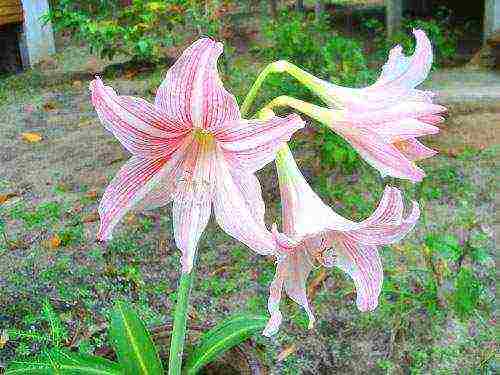 However, sometimes growers cannot get flower arrows from the plant. How to care for hippeastrum so that, in addition to the leaves, the bulb regularly forms flower stalks? The reason for the lack of flowers is often incorrectly selected growing conditions for hippeastrum or the properties of the bulb:
However, sometimes growers cannot get flower arrows from the plant. How to care for hippeastrum so that, in addition to the leaves, the bulb regularly forms flower stalks? The reason for the lack of flowers is often incorrectly selected growing conditions for hippeastrum or the properties of the bulb:
- A bulb that stays in a shaded place for a long time or on northern windows, where there is not enough light all year round, can refuse to bloom.
- With an overly spacious or cramped pot, the hippeastrum also sometimes does not bloom.
- The quality of flowering is negatively affected by an incorrectly selected irrigation regime, top dressing, and even the composition of the soil.
- Do not forget about the necessary 2.5-3 months rest for the bulb, when the hippeastrum is sent to a cool, dark place.
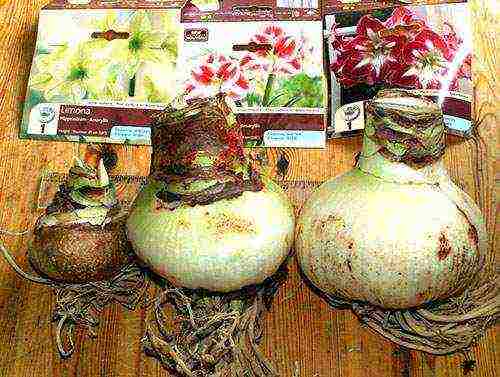 If there are no apparent reasons for refusing to bloom, the bulb is healthy and well-nourished, it can be forced to discard the peduncle by resorting to one of their proven methods:
If there are no apparent reasons for refusing to bloom, the bulb is healthy and well-nourished, it can be forced to discard the peduncle by resorting to one of their proven methods:
- In the middle of summer, all leaves are cut from the bulbs and watering is stopped. After a month, watering is resumed and a single complex feeding is carried out. By the beginning of autumn, buds and flowers appear on the hippeastrum.
- A set of buds is also observed 20-25 days after the three-hour treatment of the bulb with water heated to 43-45 ° C.
- For the spring flowering of hippeastrum in August, the plant ceases to be watered and until January is transferred to a dark, cool place in a dark place. 5-6 weeks after resuming watering, the bulb will bud.
 For high-quality flowering, it is important that during the growing season and rest the bulb can recover and form a peduncle. If the bulb lacks nutrition, perhaps the moment has come when it is simply necessary to transplant the hippeastrum. This may be evidenced by the braiding by the roots of the entire earthen coma. Do not forget about feeding the hippeastrum.
For high-quality flowering, it is important that during the growing season and rest the bulb can recover and form a peduncle. If the bulb lacks nutrition, perhaps the moment has come when it is simply necessary to transplant the hippeastrum. This may be evidenced by the braiding by the roots of the entire earthen coma. Do not forget about feeding the hippeastrum.
Longer recovery during the growing season and during the dormant period require small bulbs, as well as those that have suffered some kind of disease or pest attacks.
The dormant period involves removing healthy, well-prepared bulbs in a cool, dark place. Most often, the bulbs of hippeastrum "fall asleep" from September to January. How to care for a flower so that the hippeastrum blooms in due time? Special care is not required at this time, and special conditions are created for the bulbs:
- The optimum temperature is 12-14 ° C.
- Complete blackout.
- The air is dry, the humidity does not exceed 50-60%.
- Watering and feeding is completely stopped.
How and when to transplant hippeastrum?
Hippeastrum quickly assimilate an earthen lump in a pot and literally suck out all the nutrients from the soil.
 Therefore, the plant can be transplanted almost every year. When is it more convenient and painless for a plant to transplant hippeastrum? The best time to transplant a bulb is:
Therefore, the plant can be transplanted almost every year. When is it more convenient and painless for a plant to transplant hippeastrum? The best time to transplant a bulb is:
- before being sent for storage during the dormant period;
- after the release of their "hibernation";
- before flowering;
- after the end of flowering, in the case of a newly acquired plant in a transport pot and substrate.
Before replanting hippeastrum:
- dead scales are carefully removed from the bulbs;
- study the root system, if necessary, cutting off rotten or damaged roots and treating the cut with a fungicide.
The soil for hippeastrum should be light, loose, low in acidity and high in nutrients and mineral salts.
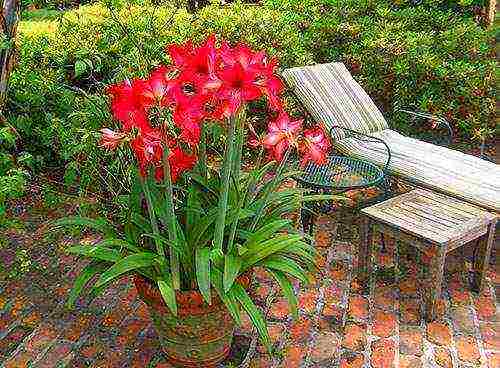 If you have to buy a ready-made mixture, for growing hippeastrum, it is better to choose soil for bulbous crops, and then, to make it friable, shift it with vermiculite or sand.
If you have to buy a ready-made mixture, for growing hippeastrum, it is better to choose soil for bulbous crops, and then, to make it friable, shift it with vermiculite or sand.
 When the earthen mixture is compiled independently, three parts of leafy earth and an additive from one part of humus are used, if necessary, sand and dolomite flour are mixed into the soil:
When the earthen mixture is compiled independently, three parts of leafy earth and an additive from one part of humus are used, if necessary, sand and dolomite flour are mixed into the soil:
- To grow hippeastrum, a pot is enough, the walls of which are 3 cm away from the bulb. More capacious dishes only harm flowering.
- At the bottom, a drainage layer must be arranged.
- And the bulb is planted so that most of it remains above the ground.
In the summer months, the bulbs can be planted in open ground, where the same care for the hippeastrum continues, in the photo, as at home. And before freezing, the bulbs are dug up and transferred to the room.
Lighting for growing hippeastrum
Hippeastrum are photophilous and feel best in the most illuminated places, even enduring direct exposure to the sun.
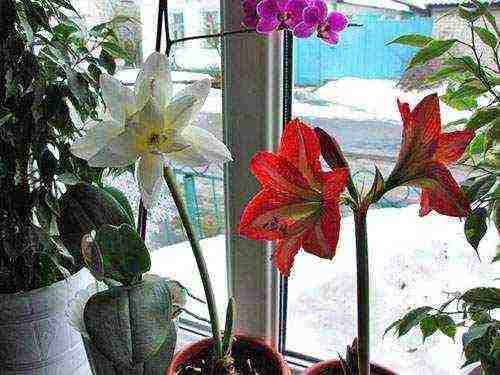 But in the shade, the plant does not bloom well, the bulb recovers and grows more slowly. The lack of light can be judged by the pale, elongated leaves and peduncles. In the shade, your plant may not bud at all. If you want to see beautiful blossoming inflorescences on your window, choose the windows on the south side of the house.
But in the shade, the plant does not bloom well, the bulb recovers and grows more slowly. The lack of light can be judged by the pale, elongated leaves and peduncles. In the shade, your plant may not bud at all. If you want to see beautiful blossoming inflorescences on your window, choose the windows on the south side of the house.
Air temperature and features of watering when growing hippeastrum
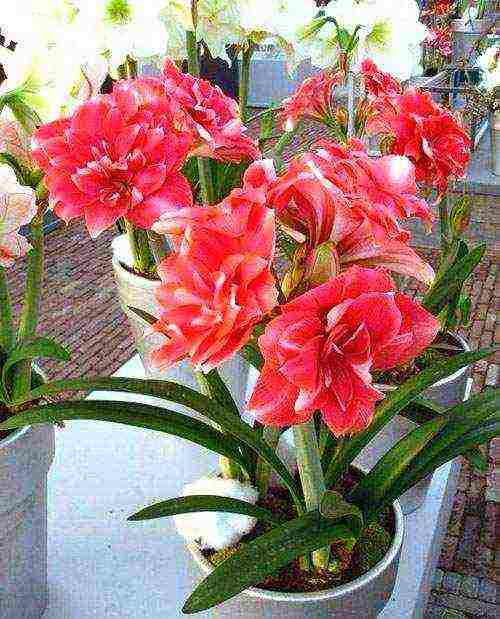 So that the plant has flowers for as long as possible, at home caring for the hippeastrum provides for the creation of optimal temperature and humidity conditions.
So that the plant has flowers for as long as possible, at home caring for the hippeastrum provides for the creation of optimal temperature and humidity conditions.
- The daytime air temperature is 20–22 ° C;
- At night, the air should be somewhat cooler, around 18 ° C.
Hippeastrum does not like temperature extremes; during storage it is important not to drop the temperature below +5 ° C, which can damage the flower buds. But in the garden, a plant can withstand short-term frosts down to –1 ° C if it is covered with a non-woven material.
The optimum air humidity for this type of bulbous is 75–80%.
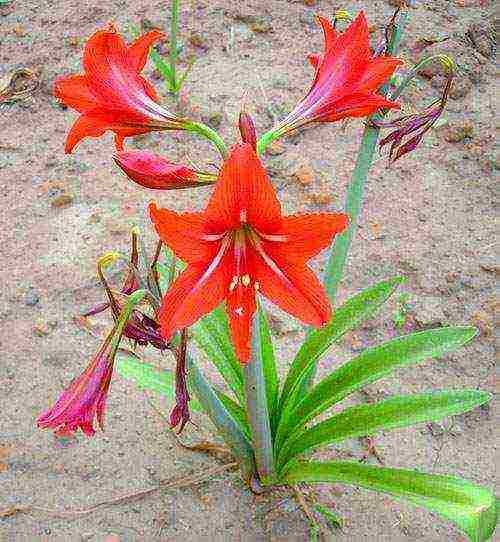 Watering when growing hippeastrum also has its own specifics. Until the arrow rises by 10-15 cm, the plant is moistened moderately, making sure that the topsoil dries out between waterings.
Watering when growing hippeastrum also has its own specifics. Until the arrow rises by 10-15 cm, the plant is moistened moderately, making sure that the topsoil dries out between waterings.
As the flowers begin to open, the amount of moisture increases, trying to prevent overflow, which is dangerous for the roots.
Top dressing of hippeastrum
 The first feeding of the hippeastrum is carried out no earlier than 4–6 weeks after the “awakening” of the plant. Then the flower should receive support in the form of fertilizers every two weeks, and the last feeding is carried out for a month before the bulb is sent to rest.
The first feeding of the hippeastrum is carried out no earlier than 4–6 weeks after the “awakening” of the plant. Then the flower should receive support in the form of fertilizers every two weeks, and the last feeding is carried out for a month before the bulb is sent to rest.
Top dressing is always combined with watering so that fertilizers get into wet soil.
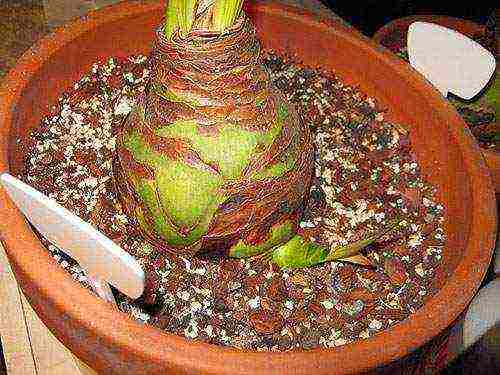 The most important element in the nutrition of the hippeastrum is potassium. When hippeastrum blooms, it is fertilized with a phosphorus-potassium mixture with a small addition of nitrogen. As the leaves appear, the proportion of nitrogen is increased, bringing it to the amount of phosphorus. From May until the end of summer, you can alternate fertilizing with organic and mineral fertilizers.If a complex ready-made composition is used, it is better to choose a mixture for bulbous, where the ratio of nitrogen, phosphorus and potassium is 1: 3: 4.5.
The most important element in the nutrition of the hippeastrum is potassium. When hippeastrum blooms, it is fertilized with a phosphorus-potassium mixture with a small addition of nitrogen. As the leaves appear, the proportion of nitrogen is increased, bringing it to the amount of phosphorus. From May until the end of summer, you can alternate fertilizing with organic and mineral fertilizers.If a complex ready-made composition is used, it is better to choose a mixture for bulbous, where the ratio of nitrogen, phosphorus and potassium is 1: 3: 4.5.
How to care for hippeastrum if the plant is grown without soil, on a nutrient solution? In this case, 10 liters of water will require:
- 3 grams of magnesium sulfate;
- 9 grams of potash fertilizers;
- 3 grams of ammonium nitrate;
- 7 grams of superphosphate
- as well as a mixture of trace elements.
When growing hippeastrum, you need to remember that an excess of nitrogen threatens with diseases. Such bulbs can rot and tolerate a dormant period worse.
Video about flowering hippeastrum
We have collected for you the most complete collection of tips and secrets for caring for hippeastrum at home. From the article you will learn all the most common difficulties that arise when growing hippeastrum, as well as all the necessary information on watering, lighting and other rules for caring for this flower.
It should be noted (!) That hippeastrum is often confused with amaryllis, which may cause certain difficulties. Choose your seedlings carefully to prevent disappointment.
Hippeastrum are very beautiful perennial flowers with over 90 species. This will allow you to choose the plants that are right for you and your garden and interior, and satisfy any taste preferences. Hippeastrum will be able to please everyone and everyone, and decorate a wide variety of flower arrangements.
General information about Hippeastrum
Sometimes this plant is confused with amaryllis - they are really close, but not the same. Hippeastrum is a perennial flower that grows from a bulb. Its foliage is linear, growing more than half a meter in length and five in width.
Flowers, similar to umbrellas, form inflorescences, appear on a high peduncle. After flowering, a box with seeds appears, which have a very high germination capacity, being fresh.
This plant has features that need to be remembered.
- varieties in which inflorescences are white or light in color usually form low-quality seeds.
- in summer it is advisable to bury plants in open soil
- flowering hippeastrum lasts only 10 days.
- to make forcing, you only need to take large onions.
The following varieties are quite popular:hippeastrum hybrid, charisma, papilio, picoty... The mix is a mixture of different hippeastrum seeds. 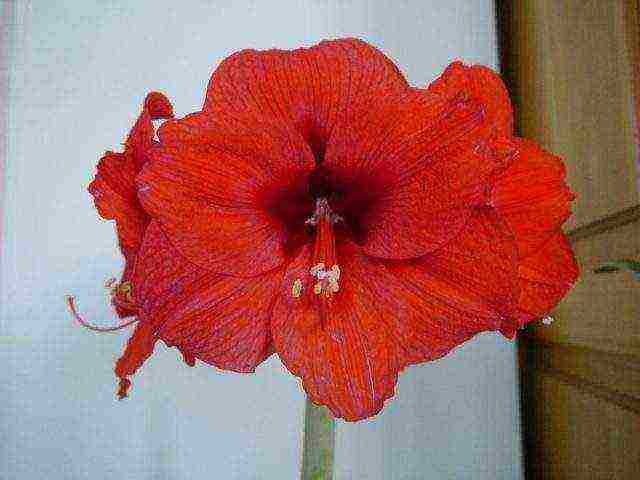
Hippeastrum, Latin -Hippeástrum.
Amaryllis family. Homeland - tropical America. About 75 species are widespread in nature. Currently, there are a large number of varieties that differ in the shape and color of the flowers, all of them are combined into the species Hippeastrum hortorum garden Hippeastrum hortorum. This plant has a large bulb, up to 20 cm in diameter, which is only half deep into the soil.
Belt-shaped leaves are collected in a basal rosette, about 50 cm long. Flowers are collected in 2-4 pieces in an umbrella-shaped inflorescence on a long (up to 1 m) peduncle. The perianths are wide, up to 20 cm in diameter, bell-shaped, of a wide variety of shades: white, pink, red, burgundy, yellow, variegated. It has large stamens with bright yellow anthers. Blooms in February - early March.
History
The cultivation of amaryllis and hippeastrum in countries with a temperate and cold climate became possible only from the end of the 17th century, when the active construction of greenhouses in botanical gardens and private estates began.... Foreign rarities were brought by seafarers, botanists and hunters for plants encouraged by traders. In the 18th century, many of Linnaeus's students took part in difficult and dangerous expeditions that sometimes ended tragically. The genus Amaryllis - the predecessor of Hippeastrum - was established in 1737 in the work "Hemera plantarum". The plants assigned to it were previously called by botanists lilies (Lilium) and lilionarcissus (Lilio narcissus).
- In the description of the garden of the burgomaster of Amsterdam G. Clifforth, Linnaeus mentions four types of amaryllis, including A. beautiful (A. belladonna), and in the famous book "Species plantarum" (1753), he already lists nine species of amaryllis. Later, in the process of botanical research, descriptions of amaryllis from Mexico, Venezuela, Peru, Brazil and other countries appeared.
- In 1821 W. Herbert established a new genus - Hippeastrum. He attributed to it more than 15 American species, discovered by himself or published earlier, including some of Linnaeus's amaryllis.
- Their former names have become synonymous. Later, many hippeastrums were described by other botanists, for example, R. Baker - 25 species, R. Filippi - about 15, H. Moore - more than 10. Now there are descriptions of about 80 species of hippeastrum and one type of amaryllis.
The modern names of the hippeastrum were not received immediately after the description of this genus by Herbert. For a very long time, confusion and confusion reigned in the taxonomy of these plants. True, some species, previously called amaryllis, were attributed to hippeastrum, others "migrated" to neighboring, closely related genera. 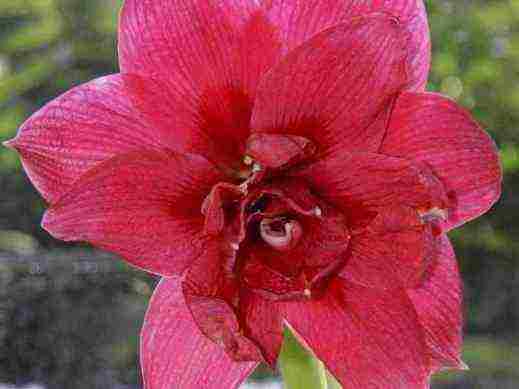
Hippeastrum flower - features
Hippeastrum flowers are bulbous perennials. The rounded, sometimes conical bulb of the hippeastrum consists of a short, thick stem and closed scales. The size of the bulbs, depending on the species, ranges from 5 cm to 10 cm in diameter. At the base (bottom) of the bulb is a bunch of filamentous roots.
- The leaves of the hippeastrum are linear, grooved on the surface, keeled below, 50-70 cm long, 4-5 cm wide, arranged in two opposite rows. In some varieties, the leaves may be purple in color, but they are mostly green.
- Umbellate inflorescence of 2-6 bisexual flowers 13-15 cm in length and up to 25 cm in diameter is formed on a cylindrical, hollow, leafless peduncle 35-80 cm in height.
- Flowers, funnel-shaped or tubular, are located on long petioles, the color of the flowers is very different: dark red, bright red, orange, pink, white, etc.
- The fruit is a tricuspid capsule, spherical or angular, in which small seeds of the hippeastrum ripen. The germination rate of freshly harvested seeds is almost one hundred percent.
Homemade hippeastrum has several features that must be considered if you decide to grow it:
- - varieties with light and white flowers form few full-fledged seeds;
- - in the summertime, hippeastrum is best kept in the garden, digging into the ground;
- - the timing of the blooming of the hippeastrum can be adjusted by timing it to certain dates - this is very convenient, given that the blooming hippeastrum is a wonderful gift that replaces an expensive exquisite bouquet;
- - each flower of the hippeastrum blooms for only ten days;
- - for forcing, only large bulbs should be used, in which a large supply of nutrients has been accumulated.
Home phytodesign in the highest class
You can use the hippeastrum flower to decorate any room, but it looks most impressive in the living room, hall, study, dining room. It is best to place the composition in the center of the room, on tables, special flower stands. At the same time, it is desirable to decorate the flowerpot. This flower is quite beautiful in cut, in various compositions. Amaryllis, hippeastrum are plants with which not every indoor flower can compare in expressiveness and attractiveness. To enhance the impression of his most beautiful creation, experts recommend using not one plant, but several. It is recommended to combine them into a luxurious ensemble. These flowers look unusual in the interior of the apartment, thanks to their catchy and sophisticated beauty.
When drawing up floral masterpieces, one must also remember that home hippeastrum stimulates performance. Therefore, it is often advised to put pots with this plant in offices, home offices, libraries.
Depletion
Stimulating energy allows you to maintain the necessary mental balance, contributes to making the right decisions. It is this property that imposes the following growing condition: during flowering, the pet is depleted, it needs regular rest, it is impossible to stimulate the ejection of buds all year round.
Hippeastrum is a beautiful home creation, which is distinguished by large, attractive, bright colors. In cultivation, it is not so whimsical, although it requires adherence to some simple rules. It starts to hurt when care is significantly violated. Hippeastrum is often used in phytodesign, allowing you to create unusual, stylish compositions.
Hippeastrum home care
To grow hippeastrum, you need to choose a place for it with a large amount of light, but the rays should not fall directly on it - the light needs diffused, but bright.
- During the growing season, the temperature should be at least twenty degrees, but not higher than twenty-five.
- Hippeastrum is an indoor plant, photophilous, but it does not tolerate direct sunlight.
- During the growth period, hippeastrum is able to withstand any room temperature, however, a temperature of more than 20 degrees is considered comfortable for rich flowering.
- The earth in a pot and the presence or absence of feeding worries him a little: during the flowering period, he spends the energy collected in the bulb over the past season.
- When forcing the peduncle in water or an inert substrate, this should be taken into account.
The dormant period of the flower is very pronounced: in August-September, the leaves stop growing and completely die off, and in October-January a new arrow appears. 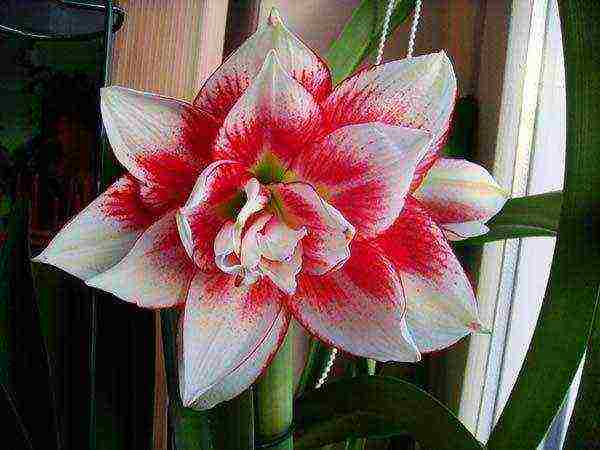
Bulb selection, planting, transplanting
When choosing hippeastrum bulbs, get down to business seriously. Examine each onion carefully.They should be smooth, heavy, with dry brown-golden scales, with good living roots..
- When buying hippeastrum in a pot, already with leaves, pay attention to its appearance.In a healthy plant, the leaves are bright green, shiny, hold well on their bases.... In the weak and sick, drooping and dull.
- If the bulb has a red border and a dotted pattern - these are signs of a fungal disease(red burn or red rot). It is better to refrain from such a purchase: the plant will have to be treated for a long time.
- The next step is landing.Hippeastrum grows in any garden soil... But maximum decorativeness can be achieved if the composition of the soil is as follows: turf soil, humus, peat in a ratio of 1: 2: 1 with the addition of wood ash and bone meal. The latter can be replaced with double superphosphate (2 tsp for a 1 liter container). Phosphorus provides plants with a lush bloom.
The pot for the hippeastrum should not be too large: the distance between its walls and the bulb is the thickness of the finger. Otherwise, the flower will grow the root system, lush leaves, acquire children, and refuse to bloom. But at the same time, the capacity should be quite stable, since the plant is large, and the flowers in some varieties reach 20-22 cm in diameter. They are especially heavy in terry forms. And when planting, the bulb is buried 1/2 of the height, that is, it is half visible from the pot.
- At the bottom of the pot, drainage is made of expanded clay with a layer of 1–2 cm, a mound of soil is poured, an onion is placed on it, the roots are carefully straightened and covered with earth to the middle.
- It is impossible to water the planted plant from above - the soil can be compacted, which will lead to decay of the roots. Better to water through a sump.
- Young plants are transplanted annually in early spring with a complete replacement of soil, and strong adult hippeastrum - once every 2-3 years, soon after flowering... This must be done very carefully, trying not to damage the leaves. Between transplants, the top layer of soil in the pot is changed annually.

Resting care
The maintenance of the hippeastrum during the dormant period requires a low temperature (+10 degrees), darkness and dryness, but not a basement.Cut off all yellowed, dried leaves. Around December - early January, we take out the pot with hippeastrum from the darkness and put it on the shady windowsill. When the peduncle hatches and grows up to 10 centimeters, we rearrange it to the lighted side.
By the way, it is quite possible to grow hippeastrum without a dormant period. To do this, it is enough to constantly keep it in a sunny place, water it as needed. It will bloom with you with this care either in March-May, or in October-November.
We alternate flowering with rest
Hippeastrum loves systematic care. A dormant period is required, without it flowering simply will not come. After the first buds have appeared, the temperature must be kept at + 18 ° C. If conditions permit, it is better to take the pot out to the balcony, where your pet will have enough light and fresh air. It is recommended to increase watering as it grows, but it is also impossible to fill in the soil.
Hippeastrum at home begins to feed closer to the summer every two weeks. Potash can be used from the middle of the summer season to set the stage for next year's flowering.
As soon as the plant has bloomed, it is recommended to give it rest so that it can gain strength until next year. In winter, the temperature should be around 12 ° C, the bulbs are best kept in a dry place, no watering is required. Exact adherence to the conditions will ensure bright flowering in the next season. 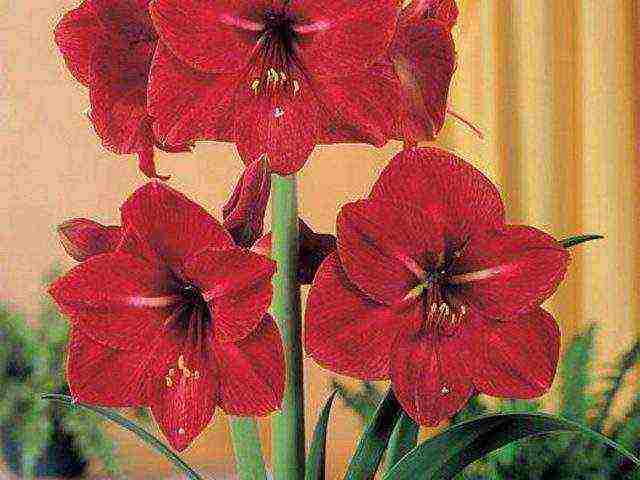
Dormant period
The resting period of the hippeastrum is from September to January. If your plant has spent summer holidays in the yard, then by the beginning of autumn it is time to bring it into the house. At the same time, they begin to gradually reduce watering, as a result of which the leaves of the plant dry out. After complete drying, the leaves fall off on their own, and the stem is cut off, the plant is transferred to a dry and dark room, the pot is placed on its side and stored at 6-12 ºC without watering for 6 to 8 weeks until it is time for the hippeastrum to wake up.
From the beginning of autumn to January, the flower begins a dormant period.
- At this time, watering should be gradually reduced. This will be the impetus for the foliage on the plant to dry out and fall off. After that, the shoot will need to be cut off, and the hippeastrum itself will be kept in a dark and dry place, where the temperature will be about 10 degrees. Watering is not necessary. In this state, the plant will stay for about six to seven weeks, and then wake up.
- Hippeastrum needs a dormant period in order to bloom annually. It usually runs from late summer to late October. When preparing the hippeastrum for the dormant period from the end of summer, it is necessary to limit watering and feeding. In many hippeastrum leaves completely die off.
- Hippeastrum, if desired, can be grown without a pronounced dormant period. Then it needs to be kept all year round on a bright, sunny window in a warm room, watered with warm water as the earth dries, preferably in a pan. With this care, hippeastrum can bloom in autumn in October - November or in spring in March - May. The dark green leaves of hippeastrum remain healthy throughout the year and do not lose their beauty.
Summer flower maintenance
In summer, if desired, hippeastrum can be planted in open ground. In the open field, hippeastrum blooms better, the bulb grows rapidly in size, gives many daughter bulbs. In the fall, with the onset of cold weather, hippeastrum is brought into the house.
Hippeastrum after flowering.
As soon as the flowering is over, the plant needs to be prepared for rest, because the quality and timeliness of the next flowering directly depends on how correctly you prepare the hippeastrum for the dormant period.
From mid-September, watering stops completely, and after the leaves fall and the wilted peduncle is trimmed, the plant is placed in a dark, dry room with a low temperature, where the hippeastrum will remain until the end of January or the beginning of February.Then the pot with the bulb is placed in a well-lit place, watering and feeding are resumed, and the next period of active growth of the hippeastrum begins.
Tableware.
Narrow and tall pots are better suited for growing hippeastrum, because in addition to the bulb, the hippeastrum also has roots that are long enough and during dormancy they do not die off, but continue to feed the bulb.
You also need to observe the depth of planting of the hippeastrum. The bulb should rise from the ground by one third. And do not try to stuff the pot with earth too much, it is better to wait until it settles itself and fill the earth to the desired height. The size of the pots should not be too wide, it is quite enough if the distance between the wall of the pot and the bulb is only 2-3 cm. In a dish that is too wide, the hippeastrum may not bloom for a long time.
Earth mix:
sod land, peat, sand, humus in a ratio of 2: 1: 1: 1. Earthen mixture for hippeastrum should be nutritious, water and breathable with a neutral or alkaline pH-reaction of the soil. Also, don't forget about the drainage layer. Also, when transplanting a hippeastrum, you can use ready-made purchased soil for bulbous.
Lighting.
Hippeastrum is a light-loving plant, therefore it is advisable to keep it in the southwestern, southern or southeastern windows. Light can be either direct sunlight or bright diffused light. Hippeastrum hybrids that lose their leaves during dormancy, you can move the pot with the hippeastrum bulb to a cooler and darker place.
Air temperature.
Hippeastrum grows well at room temperature. In summer, the usual room temperature is +20 +25 C. In winter, the air temperature can be slightly lower.
Watering and feeding
Watering the plant during the period of growing green mass needs minimal watering, but it must be increased a little before flowering. Before flowering, watering should be done abundantly, but only so that the ground is not wet.
- Only settled, not cold water can be used for the procedure. You need to water so that the liquid does not get on the bulb.
- At the end of flowering, you should begin to reduce watering and later stop altogether.
- The leaves of the hippeastrum, for hygienic purposes, should be wiped from time to time with a damp cloth. When the peduncle reaches 15 cm in height, the earth should be watered with a manganese solution.
And after five days, fertilize the flower with phosphorus fertilizing. And in general, feeding during the growing season should be carried out every 15 days with a means for deciduous plants. With the advent of foliage, agents for flowering plants are used. 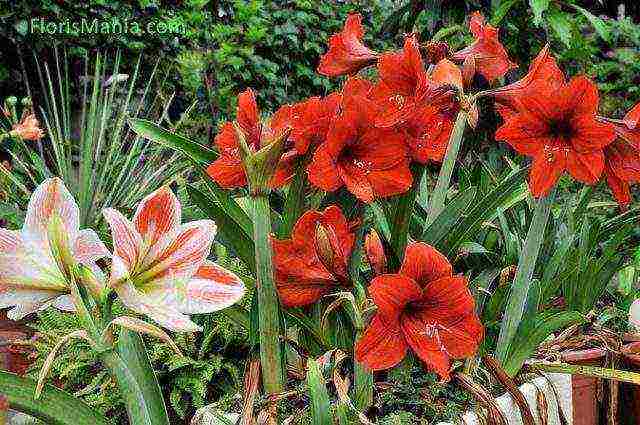
Proper watering
During the period of active growth and lush flowering of the plant, watering should be strong and abundant, after the soil in the pot dries out. But gradually, with the approach of the rest period of the hippeastrum, the amount of water must be reduced, and after all the leaves have died out, completely stop. It is only permissible to add a small amount of water to the pan of the pot to maintain the viability of the rhizome.
- During the calm period of the flower, the earth should feel dry, since excess moisture can provoke the growth of a new leaf, which will subsequently harm the flowers of the hippeastrum. After the start of the growth of a new peduncle, we begin to water again, but little by little.
- At the beginning of winter, in order for the hippeastrum to wake up, come out of the dormant period, it is placed on a light window. During this period, the hippeastrum has no leaves, it is not watered, otherwise the bulb can be easily destroyed. Until the flower arrow appears, the hippeastrum does not need to be watered.
- After the appearance of the peduncle and before the flower arrow grows up to 7-10 cm, watering of the hippeastrum should be weak, otherwise the leaves will begin to grow to the detriment of the flowers. Watering is best done in a pan or along the edge of the pot, without getting water on the bulb. As the peduncle grows, watering increases.
After the flowering of the hippeastrum, leaves and a bulb begin to grow, new flower stalks are laid for the next year, during this period watering should be regular. By the end of summer, watering stops. At this time, the hippeastrum begins a period of rest. The pot with hippeastrum can be put in a cool place and not watered. If the room temperature is high, you can water it occasionally a little to keep the bulb from drying out. Hippeastrum does not need high air humidity, so it does not need air spraying, it prefers dry content. 
Water procedures
Water the hippeastrum at the beginning of the growing season, it is necessary very sparsely, gradually increasing watering only from the moment the peduncle appears - a signal that the plant has begun the growing season. As the flower arrow grows and before flowering begins, watering should become abundant, but nevertheless moderate, so that the soil in the pot is moist, not wet. It is best to do bottom watering or sump watering, gradually adding warm water until the clod gets wet. Avoid getting water on the bulb. After flowering, watering is also gradually reduced until it stops completely.
When the peduncle of the hippeastrum reaches 12-15 cm in height, pour the soil with a pale pink solution of potassium permanganate, and after 4-6 days feed the plant with phosphorus fertilizer. In general, feeding of hippeastrum is carried out at the beginning of the growing season twice a month with liquid mineral fertilizer for deciduous plants, and after the appearance of leaves and for better bud formation, with fertilizers for flowering plants in the same mode. Make sure that the concentration of minerals is not too strong, otherwise, instead of fertilizing the plant, you will burn its roots.
Do not forget to wash the leaves from dust under a warm shower or wipe them regularly with a damp sponge.
Top dressing and fertilizers for hippeastrum
You need to start feeding the flower immediately after it has faded. This is necessary for the flower to accumulate strength for the next year. During this period, after the end of flowering, large long leaves grow especially intensively, and they form bulbous scales, laying new flowers in the future.
- It is better to take the hippeastrum outside until September (the beginning of the quiet period).
- If you made a decision not to send hippeastrum to a dark place, then during the period of flowering and leaf growth, the plant must be fertilized once every 10 days. It is better to do this with a mullein solution (1 in 10).
- The first feeding of the hippeastrum can be done when the height of the flower arrow is about 15 cm.
If the hippeastrum was recently transplanted and there are enough nutrients in the soil, top dressing can be done later. When feeding, focus on phosphorus-potassium fertilizers. They promote flowering, the accumulation of nutrients in the bulb, the laying of future flower stalks. But it is better to exclude nitrogen fertilizers, they can provoke gray rot, and the plant can be irretrievably lost. 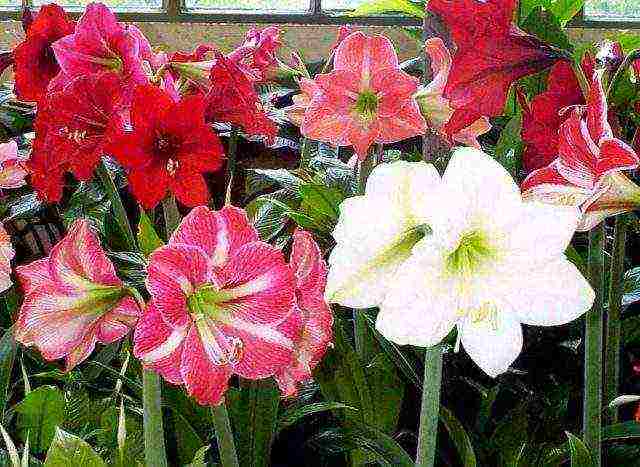
Transfer
Hippeastrum transplant is carried out 3-4 years after planting, and then every year. This procedure must be performed before the beginning of the rest period or immediately after its end. The pot for transplanting needs to be taken a couple of centimeters larger than the past.
The composition of the soil for transplantation should contain 2 shares of perlite, according to the share of leaf and sod land and a share of humus. Also, be sure to put drainage in the container. It is necessary to move the flower by transshipment so that the rhizome of the hippeastrum is not damaged.
The bulb must be covered with a substrate so that a third of it is on the surface.
Immediately after the end of the flowering of the hippeastrum, it is necessary to cut off the wilted flowers, and plant the onion in a small pot 2/3 in the ground. If the plant is not strong enough, it is rarely recommended to replant it - once every 3 years. The diameter of the pot in which the hippeastrum bulb is placed should be 6-7 centimeters larger than the diameter of the bulb.The composition of the soil for planting is similar to that of amaryllis - leafy and soddy soil, sand, peat, humus (1: 1: 1: 1: 1).
Transfer.
Hippeastrum is transplanted every three to four years before the rest period or before leaving it. It is very important to choose the right pot for a flower: the distance from the bulb to the wall of the pot should not be more than 2 cm.The soil should be of approximately the same composition: two parts of perlite (or coarse sand), leaf and turf soil and one part of humus.
The soil must be sterilized before use. Don't forget about the drainage layer. The planting of the hippeastrum is carried out in a transshipment manner in order to cause as little damage as possible to the root system of the plant. The bulb is placed in the ground so that at least one third of it is above the surface.
30-40 days after the end of flowering, hippeastrum can be transplanted. An annual transplant is not at all necessary, but in this case, change the top layer of the earth every year, because hippeastrum quickly consumes nutrients from the soil, and this will later affect flowering. You can also transplant hippeastrum before it leaves dormancy, that is, at the end of December. 
Bloom
In order for the hippeastrum to bloom for sure, there are several floricultural tricks that we are ready to share. First, the bulbs can be treated with 43-45 ºC hot water for three hours before planting. After such a temperature extreme, the plant blooms in three weeks. The second method of exposure: from August, stop watering the plant, move it to a dry, dark place and keep it there until the end of January, then resume watering. In a month and a half you will be able to enjoy the flowering of hippeastrum.
- And the third way of persuasion: cut off all the leaves of the hippeastrum in July and do not water it for a month, but with the first watering, introduce a liquid complex top dressing (in order to avoid burns, first moisten the soil through and through, then add fertilizer). In August or September, your hippeastrum will bloom like cute.
- To be sure that the hippeastrum will bloom, you can resort to some tricks. Let's say hold the bulbs in warm water for three hours, the water temperature should be about 44 degrees.
- You can also stop watering the flower in August by moving it to a dry, warm room. So the hippeastrum should stay until January - at this time it will be possible to water it again.
To help the plant bloom, you can cut off all the foliage in July and stop watering for 30 days. Watering the flower for the first time after a break, add complex fertilizer to the soil.
Which breeding method should you choose?
Indoor hippeastrum reproduces in various ways, usually no difficulties arise. The most difficult can be called the use of seeds, since to obtain them it is necessary to provide artificial pollination of the flower. This method is not recommended in the absence of experience. In addition, the first flowering after planting the seeds occurs only after 2-3 years.
Simple breeding methods that are available even to beginners are dividing the bulbs, vegetative propagation by children. Children can appear in a plant at any time of the year, their number depends on which variety is grown, what conditions are met.
Children are separated during transplantation. They must be carefully cut or broken off, after which all the cuts must be sprinkled with crushed coal. The pots are taken small so that the distance between the wall and the bulb (baby) is only 2-3 cm. Dutch varieties are propagated using scales, since they have a minimum number of children. The question of how to care for hippeastrum at this time is easy to solve. The soil is taken as for an adult plant, no special conditions need to be created. 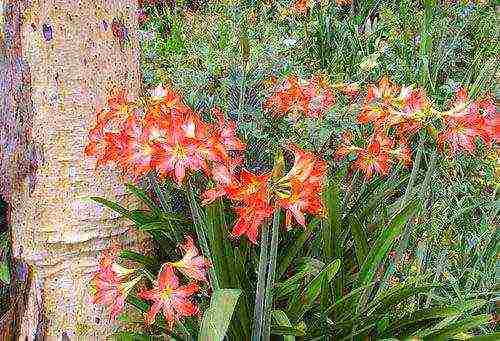
seed propagation
Hippeastrum can be propagated using seeds or vegetatively.
You need to sow seeds as soon as they are harvested, since fresh seeds germinate very well. If the material is allowed to dry, its germination will immediately drop dramatically. There are no special wishes for the sowing process - the seeds just need to be placed in the soil.
Hippeastrum lends itself to reproduction by seeds, but to obtain them, the flowers will need to be forcibly pollinated, and the seedling rarely blooms in the first two years and does not retain maternal characteristics.
Children
The easiest way to reproduce this flower is by children. However, more and more often, gardeners are practicing dividing the bulb. For a successful separation, a good, strong onion is needed, which should be cut in half so that an equal piece of scales and a bottom remains on each part. Sprinkle a fresh onion cut with charcoal or activated charcoal, and then plant the slices in a light peat mixture. In about 1.5-2 months, new babies will appear. Plant them in new pots when spring comes.
By dividing the bulb
But it is better to use the vegetative method for reproduction.
- When transplanting, you just need to take the children from the bulb and plant them, having previously powdered with charcoal.
- And another vegetative way is the division of the bulb.
- At the end of autumn, you need to open the bulb, remove dry scales from it and make 4 vertical cuts. A knitting needle is pushed into each slice (only not an iron one).
The bulb is looked after as an adult hippeastrum. With the appearance of leaves, you need to start fertilizing the plant. Next spring it will be possible to separate the material and plant it in separate containers.
How to further increase the number of plants
Hippeastrum is easily propagated by daughter bulbs, which are completely identical to the parent plant. Babies larger than two centimeters are separated from the main bulb during transplantation. Young plants bloom in 2-3 years.
But what if some varietal hippeastrum does not form babies? In this case, the hippeastrum can be propagated as follows: cut the healthy bulb of the hippeastrum with a clean and sharp knife into two or four parts so that each lobe has a part of the bottom. Carefully process the slices of the onion with crushed charcoal and dry for two to three days. After the cut has dried, each lobe can be added to a mixture of sand and peat or perlite. It is not necessary to deepen such a bulb, it should simply lie on its bottom on the surface of the earthen mixture.
But you can not completely cut the hippeastrum bulb to the end, but make only deep cuts, so that the bulb is divided into two or four parts, but does not fall apart at all. The sections are likewise processed with crushed coal and also dried for two to three days. After that, the bulb is simply placed on an earthen mixture of sand and peat or perlite. Watering of such bulbs is carried out only through the pallet. After a while, babies appear at the base of the cut onion.
Other methods
Hippeastrum can be pollinated and propagated by seed. In this case, sometimes a completely unpredictable result is obtained (so to speak, a breeder for himself).
- After pollination of the hippeastrum, a seed capsule is formed on the peduncle.
- In this case, the peduncle does not need to be removed, wait until the seeds ripen.
- But remember that such a procedure can greatly weaken the bulb, which will further affect flowering again: the flowers will be smaller, or the plant will not bloom at all.
- An experiment with hippeastrum seeds is good to carry out in the open field, where the bees fly, and the bulb will pick up nutrients from the ground during the ripening of the seeds.
Seeds of hippeastrum are sown immediately after harvest, otherwise they quickly lose their germination. Embedding seeds to a depth of one centimeter, seedlings appear in two to three weeks. Hippeastrum seedlings are photophilous, so place them in a bright place.To make small hippeastrum grow better, you can do top dressing with a weak solution of liquid mineral fertilizers. Young hippeastrum does not need a rest period. 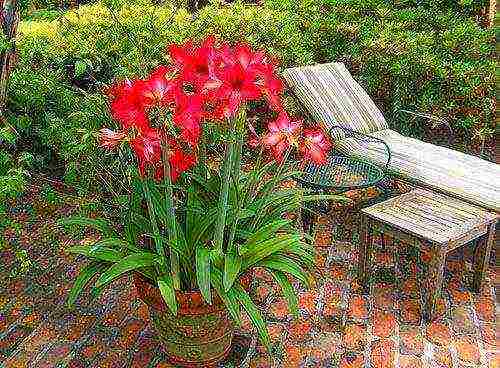
Reproduction
Hippeastrum reproduces by seed and vegetative methods. Sowing seeds is best done immediately after they are harvested, as long as they have one hundred percent germination. If the seeds are allowed to dry out, then the ability to germinate becomes only thirty percent. Actually, sowing seeds is a simple, routine procedure, so there is no point in talking about it, especially since the seed method can be used only if there are seeds, and they can appear if you do artificial pollination of a flower.
It is much easier to carry out reproduction in a vegetative way, namely, by separating the babies of the hippeastrum from the mother's bulb. This is done during the transplant. Separated with a sterile sharp instrument, the baby, having treated the cuts on it with crushed coal, is placed in a separate pot and for two years we do not deprive the young plant of its foliage even during the dormant period.
There is another way of vegetative propagation of the hippeastrum - by dividing the bulb. It is carried out in November, when the bulb contains the maximum amount of nutrients. Remove the top layer of the substrate so that only the bottom of the bulb remains in the soil. Remove the outer dry scales.
Cut off the leaves by grabbing some of the top of the bulb. Cut the onion vertically into four equal parts so that the cuts reach the surface of the substrate, insert plastic or wooden knitting needles with a diameter of 5-6 cm vertically into the cuts so that the parts of the onion do not overlap.
Take care of the bulb as if it were an adult plant, without letting the substrate dry out. As soon as leaves appear, fertilize and continue fertilizing as usual. Divide the onion and plant the parts in individual flowerpots next spring. 
Growing difficulties
The most common problems in growing hippeastrum are red rot, downy mildew and red burn fungus. And, of course, the aforementioned pests - scale insects, aphids, worms and spider mites, which are destroyed with special insecticides.
- You can determine what the plant is sick with by how the hippeastrum looks like. If there are red spots on the leaves and on the bulb, then this is a fungal burn, if the white bloom is powdery mildew, and if the leaves hang sluggishly, and rot is visible on the scales of the bulb, then this is rot.
- If there are signs of rot disease, all affected areas, diseased roots should be removed, the bulb should be dried, and immediately before planting in a new sterile substrate, the bulb should be etched with foundation. They are saved from powdery mildew with special preparations available on the market.
And the red burn is eliminated by removing the bulb from the ground and cutting out all the foci to healthy tissue. Then the wounds are sprinkled with a mixture of chalk and copper sulphate in accordance with 20: 1 and the bulb is dried for a week, after which they are planted in a fresh substrate, previously treated with fungicides.
Diseases and pests
Various problems can arise with hippeastrum.
- For example, the lack of flowering - usually this happens with a lack of fertilizer or poor soil. Also, flowering does not start if the bulb is rotten.
- The yellowing of the leaves of the plant is most likely associated with root decay or the appearance of pests sucking juices, but in this case, yellowing is followed by drying of the foliage.
- Sticky marks on the leaves appear due to the scale insects.
- Also, hippeastrum can infect aphids, mealybugs, spider mites.
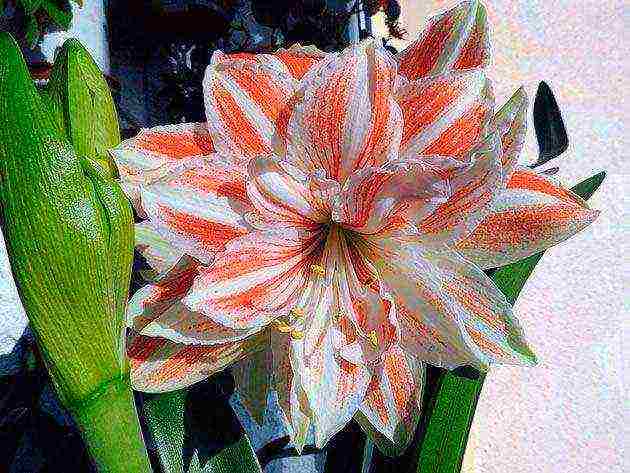
Pests.
The main pests of hippeastrum are spider mites, mealybugs, scale insects, and onion mites. Pests visible to the naked eye can be removed manually with a sponge or cotton swab dipped in an alcohol solution, after which the plant is repeatedly treated with a solution of actellik, phytoverm or karbofos.
When planting in open ground, do not plant hippeastrum next to other bulbs, for example, lilies, otherwise the hippeastrum may be damaged by an onion mite. The bottom of the bulb begins to rot and gradually the entire bulb rot.
Diseases.
One of the most dangerous diseases of the hippeastrum is the red burn of the bulbs, or staganosporosis. At the first detection of red streaks and dots on the bulb of the hippeastrum, without regret, cut out all foci of infection to healthy tissue. Trim off all affected leaves and dead roots. All slices and the bulb itself must be treated with phytosporin, foundation, Maxim.
Dry the processed hippeastrum bulb for a week, see if new foci of infection appear. If everything went well, then plant the hippeastrum bulb in a new pot and a new substrate. At first, the minimum watering and only in a tray with solutions of phytosporin, foundation to ensure disinfection. Planting the bulb in this case should be as high as possible, this will allow you to control the condition of the bulb. If everything goes well, then the soil can then be filled up to the desired height. The main thing is to save the onion.
In addition to a red burn, hippeastrum can be affected by anthracnose and fusarium. The treatment is almost the same as for a red burn: removal of damaged tissues, repeated treatments with phytosporin, foundationol, Maxim.
Remember, diseases appear from an incorrectly selected soil mixture, an excess of nitrogen fertilizers, improper watering (too abundant, or water has got into the middle of the bulb), from a lack of light. If the conditions of detention are chosen correctly, then hippeastrum will delight you with its flowering for a long time. 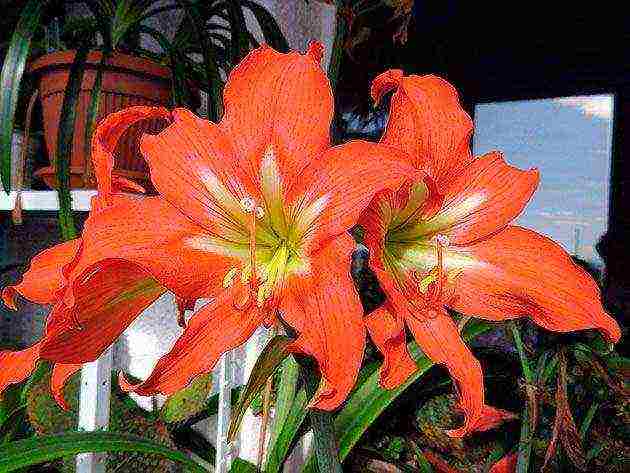
Growing problems: how to fix them?
Hippeastrum, planting and caring for which is not so difficult, can lose its decorative appearance if the necessary conditions are not followed. The most common problems are:
Red rot
that infects bulbs is considered a frequent visitor. The leaves become lethargic, traces of rot appear on the bulb and its scales. What to do in this case? At the first signs of infection, it is necessary to immediately remove all affected foci, carefully cut out diseased areas to healthy tissue, remove all dead roots.
The onion should be dried (5-7 days is enough), before planting, experts recommend etching it with foundation. After that, the hippeastrum is planted in a new substrate so that most of the bulb remains above the surface. Only the roots and the bottom of the onion remain in the soil. So it will be more convenient to observe the plant for the first time.
Downy mildew
appears when humidity is too high, there is no ventilation. If you find signs of the disease, then you need to treat the plant with any specialized powdery mildew remedy (you can buy it in flower shops). The conditions of detention also need to be changed.
Red fungal burn
Is one of the most common diseases. It manifests itself in the form of red spots on the leaves and onion.
- Treatment should be started immediately, as the plant may die.
- The bulb must be removed from the soil, cleaned of diseased and dry scales, cut out all foci.
- The wounds should be sprinkled with a mixture of chalk (twenty parts) and copper sulfate (one part).
After that, the onion is dried for about a week, then it is planted in fresh soil. It is recommended to steam the substrate, you can additionally treat it with fungicides. Planting is carried out so that the bottom remains in the soil, the roots of the onion. 
Does not bloom
It also happens that the hippeastrum at home does not begin to bloom. This happens for various reasons: excessive watering or lack of water, the bulbs are too small. Change the growing conditions, try to periodically make special feeding.The lack of flowering is also the result of the fact that your pet did not enter a state of rest.
Of the pests, it should be noted such as spider mites, thrips, aphids. It is easy to find them, the treatment is the treatment with special drugs.
If it does not bloom, then why?
Sometimes this happens due to a lack of nutrients, because the hippeastrum is a gluttonous plant, and there is very little soil in the pot, so it is quickly depleted. For this reason, fertilizing should be sufficient and regular, as should watering. And it happens that a plant throws all its strength into the fight against pests, such as a spider mite, a worm or a scale insect, and then it has no time for flowering. Hippeastrum does not bloom even when the soil is waterlogged, when the bulb begins to rot. 

Hippeastrum is a bulbous plant that came to us from the territory of Central and Latin America. The plant itself belongs to the amaryllis family, and of all the representatives of this family, hippeastrum is the most common plant.
Description of the plant
Hippeastrum can bloom twice a year, depending on the size of the plant bulb. There are many varieties and hybrid forms of this plant, which differ from each other not only in the color of the flowers, but also in their size.
Variety of colors
The leaves of the hippeastrum are linear-flat, bright green or dark green in color, their length can reach 70 cm. The leaves are usually slightly curved. One or two hollow arrows grow from the center of the leaf rosette, at the top of which flower buds are formed. The flowers of this plant are very similar to lilies, are funnel-shaped, rather large. The number of flowers on one arrow can vary from 2 to 4 pieces, in some cases the number of flowers can be up to 7 pieces. The color of the flowers depends on the variety and type of hippeastrum, usually two-colored flowers: red with greenish or white stains, pink with red stripes, white with pink spots, etc.
Choosing an onion in a store
Hippeastrum can be bought ready-made, planted in the ground with leaves, or grown from a bulb. Throughout the entire period of forcing - in autumn or spring, the bulbs of this plant will not be difficult to find in any flower shop. The choice of the bulb depends on the time and duration of flowering, as well as the health and growth of the plant.
Hippeastrum bulbs, if healthy, should look like this:
The upper scales should be dry, brown, smooth and evenly colored.
The bottom, neck and the bulb itself are dense and strong in a healthy state. The presence of various spots, growths or seals on the bulb is not allowed.
If you are buying an already planted bulb, also pay attention to its appearance. The bulb should be strong, the upper scales are brown, dry, if the bulb is soft or the upper scales are wet, then the bulb is sick with rot. If the plant has leaves, then pay attention to them, they should be evenly colored, without various spots.
White roots should be visible in the drainage holes of the pot; if they are of a different color, the plant should not be bought.
How to care for hippeastrum

Temperature regime
The ideal temperature for this plant is 23 to 25 ⁰C during the daytime, and 18 to 20 C at night. Temperature changes are especially sharp and have a very bad effect on plant growth. Even a short-term drop in temperature below 5 ° C during the period of peduncle formation can not only greatly delay flowering, but also make it impossible.
The plant needs a dormant period from time to time, in order to transfer the hippeastrum during this period, the temperature regime should be gradually reduced to 12-15⁰С.
During the dormant period, the plant bulbs should be stored at a temperature of 10 to 12 ° C, but the temperature should not be allowed to drop below 10 ° C, otherwise it will not affect the further vegetation of the plant.
Air humidity
The plant is not particularly demanding on high air humidity, so you should not raise it above 80%, otherwise the plant may get sick with stagonosporosis.
In case of insufficient air humidity, hippeastrum can be sprayed, but this is not necessary. Do not spray the plant during flowering.
Illumination mode
There are no special requirements for illumination when growing a plant.
Hippeastrum feels good both in direct sunlight and in partial shade.
Growing substrate
Light water and air permeable soils are ideal for growing a plant. It is best to take a substrate of the following composition: one part of sod or leafy soil, one part of peat and one part of river sand. It is advisable to completely replace the soil in the pot every 2-3 years.
Fertilizers and plant nutrition
Like all other indoor plants, hippeastrum needs regular feeding during the period of active growth and development. A month before the onset of the dormant period, feeding is canceled. During the growing season and growth, the frequency of fertilization should be every 10-14 days.
The composition of fertilizers directly depends on the stage of plant development.
During the period of active growth after a period of dormancy, the plant should be fertilized with potash fertilizers.
At the beginning of the growing season, nitrogen-potassium mixtures should be taken for feeding in a proportion of 4060, in the middle, before the formation of peduncles, nitrogen-phosphorus-potassium mixtures - in a proportion of 303040.
During the flowering period, phosphorus-potassium dressings are used in the following proportion of 4060.
Rules of feeding behavior
Before feeding, the plant must be watered, you should not pour fertilizer into dry soil, otherwise you can do more harm than good to the plant.
Do not fertilize earlier than a month and a half after planting the plant in the ground. Dilute the fertilizer solution strictly according to the instructions on the package.
It is best to use special fertilizer for bulbous plants to fertilize hippeastrum.
Watering
Watering the hippeastrum requires care. The thing is that the plant does not tolerate waterlogging of the soil and stagnation of water in a pot very badly. In this case, it is better to dry out the soil a little than to overflow. Watering this plant is carried out as the topsoil dries up. From overflow and stagnation of water in the pot, the plant can get sick or die.
At the beginning of autumn, watering is gradually reduced to naught, as the plant enters from a dormant state. Further watering is done every 30-40 days very moderately, when watering, try not to get on the bulb itself.
The normal watering regime is introduced starting in January, watering in moderation.
Flowering: The successful flowering of hippeastrum depends on two main factors - the availability of sufficient nutrients in the bulb, which is regulated by feeding the plant, and the correct dormancy period that the hippeastrum should receive after flowering. The rest period is worth talking about separately.
Hippeastrum landing and transplant
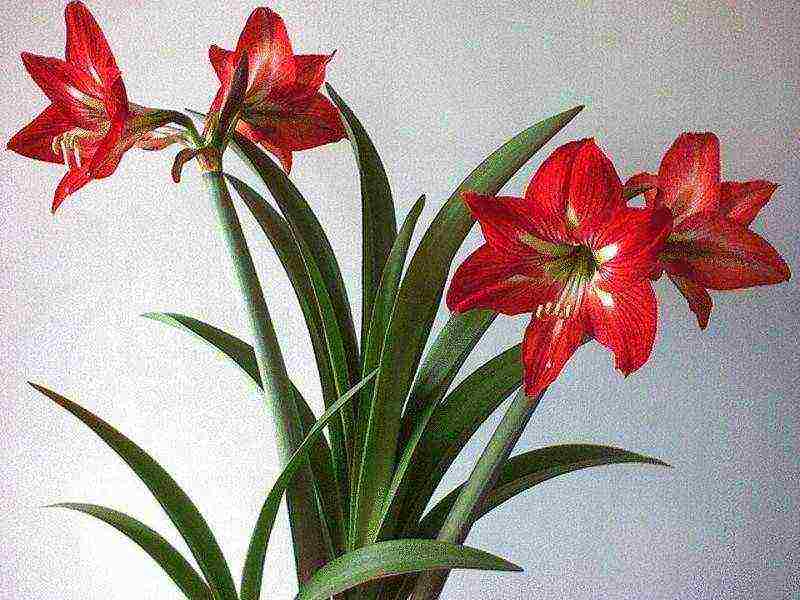
Transfer
Quite often you can hear the question how often should hippeastrum be transplanted? This plant is demanding on soil fertility and if you want it to bloom 2 times a year, it must be replanted annually. If you don't want to bother with transplants every year, then you can transplant every two years, but not less often. Otherwise, the plant will become smaller, flowers and arrows will be small.
The transplant is usually performed either before the onset of the dormant period, or at the end of it. In the remaining periods of the plant's life, it should not be transplanted, especially the period of formation of the flower arrow and the period of flowering.
Planting the bulbs
A properly planted bulb should rise one third of its thickness above ground level. Do not remove dry scales during planting, you can damage the bulb.
After deepening the bulb to the desired depth, it should be watered moderately and you can wait for germination.
Reproduction of hippeastrum
Hippeastrum is propagated in different ways: by seeds, by dividing bulbs and by children. The simplest and most common way of reproduction of this plant is reproduction by children.
Babies are daughter bulbs that grow on the sides of the mother's main bulb. In order to plant the daughter bulbs, they first need to be carefully separated from the mother bulb, if a wound has formed at the site of separation, it should be sprinkled with crushed coal to avoid infection and can be planted in a prepared substrate. The soil should be kept moist for some time after planting in order for the children to have a good root system. When the bulbs have sprouted and young leaves appear, the bulbs can be planted in separate pots. For good plant growth, you should take pots whose diameter exceeds the diameter of the bulb by 1-2 cm, the diameter of the pot can be as large as the diameter of the bulb by 6-8 cm. Bulbs should not be buried more than half the height. Further caring for young plants is no different from caring for mature plants.
Hippeastrum post-flowering care
The rest period of the hippeastrum
The flowering of the hippeastrum directly depends on how the dormant period of the plant passed. Without such rest, it is very difficult to make the plant bloom. In the usual case, around the middle of July, you should stop feeding the plant, and at the end of August, stop watering. After the leaves are dry, they must be removed, and the pot with the plant must be removed to a dark, dry place. During the dormant period, the plant should be in a room where the air temperature is maintained between 10 and 14 ° C. So the plant should be kept until mid - late December. In early January - February, the plant should be transferred to a bright place and the watering and feeding regime should be resumed. After a while, you will notice that the plant has released leaves and then a flower arrow. Usually hippeastrum blooms one and a half to two months after waking up.
Hippeastrum - why it doesn't bloom or how to make hippeastrum bloom
So, you can make the hippeastrum bloom by sending the plant for a while during the dormant period.
In addition, you can accelerate the onset of flowering by keeping the bulb in hot water for 2-3 hours before planting. The water temperature should be between 42 and 45 ° C.
Such a procedure as pruning the leaves has a good effect on the flowering of the plant, after which you need to stop watering for a month. Then follow the usual care rules and the plant will soon delight you with flowers.

